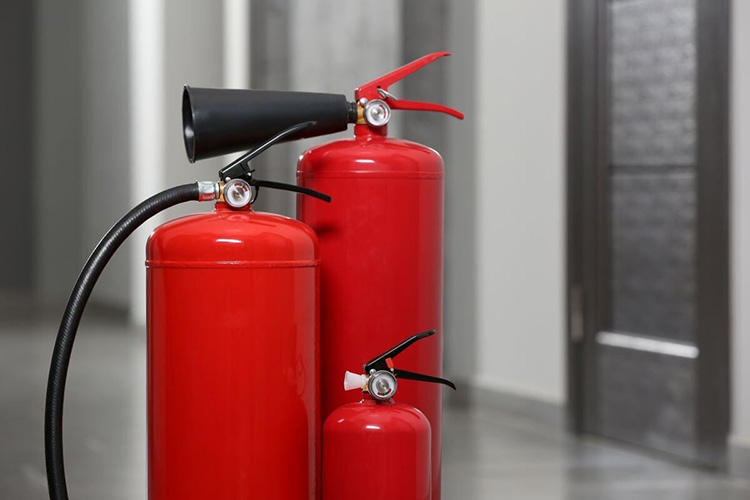What Firefighting Equipment Should Be Equipped in Homes? Choosing the Right Fire Safety Devices for Enhanced Protection
2024-12-13 16:42:33
Click:
Fire is an unpredictable disaster that can threaten the safety of a home in an instant. Therefore, fire safety awareness is crucial, and it’s important for every household to be prepared with the necessary firefighting equipment. In this article, we’ll discuss the types and functions of fire safety equipment, recommending essential firefighting devices that every home should have to enhance fire safety and minimize risks.

1. Fire Extinguishers — The First Line of Defense in Home Fire Safety
A fire extinguisher is the most basic and common fire safety device in homes. It’s used to extinguish small, early-stage fires before they spread. The most common types of fire extinguishers are dry powder, foam, and CO2 extinguishers. For homes, a dry powder fire extinguisher is highly recommended due to its versatility (it can handle solid, liquid, and gas fires) and ease of use.
Recommendation: Every home should have at least one 6kg dry powder fire extinguisher, ideally placed in high-risk areas like the kitchen or garage. It's important that all family members know how to use it.
2. Firefighting Cabinets — Convenient Storage for Firefighting Tools
A firefighting cabinet is a multifunctional storage unit designed to house extinguishers, hoses, fire masks, and other fire safety gear. When purchasing a firefighting cabinet, choose one based on your home's specific needs and the space available for proper storage.
Functionality: A firefighting cabinet helps ensure that fire safety equipment is easily accessible in case of an emergency, and it also keeps your tools organized and ready for use. Homes should consider a cabinet to store essential equipment for quick access.
3. Fire Hose — Essential for Large-Scale Fire Emergencies
Fire hoses are commonly used for extinguishing larger fires. They are particularly useful when more water pressure and volume are required to control the flames. Fire hoses, when combined with a water pump, can help quickly suppress large fires.
Recommendation: For homes in high-rise buildings or with large terraces, it may be wise to install a fire hose system. Ensure access to a water source for fast and efficient fire suppression.
4. Smoke Detectors — Early Fire Detection and Alert
Smoke detectors are crucial early warning devices that detect the presence of smoke in the air and sound an alarm to alert residents. They are especially important at night, when smoke or fire may not be easily noticed.
Installation Recommendations: Smoke detectors should be installed in every bedroom, kitchen, and hallway, as these are the most common areas where fires may start. Regularly check the batteries and functionality of these devices.
5. Emergency Lights — Guiding Your Way During a Power Outage
In the event of a fire, power outages can occur, leaving residents in total darkness. Emergency lights are essential for providing illumination, helping individuals safely evacuate and navigate the premises during an emergency.
Installation Recommendations: Install emergency lights at stairways, hallways, and escape routes to ensure they remain functional in case of a power failure during a fire.

6. Differential Pressure Controllers — Ensuring Safe Escape Routes
Differential pressure controllers are used in modern buildings to maintain airflow in emergency escape routes during a fire, preventing smoke from entering areas where people are evacuating.
Recommendation: While commonly used in commercial buildings, residential buildings in high-rise complexes or large villas should also consider installing differential pressure control systems to ensure safe and clear evacuation paths during a fire.
7. Electromagnetic Temperature Controllers & Float Switches — Smart Fire Protection for Home Appliances
With the rise of smart homes, electromagnetic temperature controllers and float switches are increasingly being used for fire prevention. These devices can automatically cut off the power or water supply when a system detects overheating or abnormal water pressure, preventing potential fire hazards.
Recommendation: Consider installing electromagnetic temperature controllers and float switches on home appliances, heating systems, and water pipelines to prevent fires caused by electrical failures or leaks.
8. Backflow Preventers & Fireproof Materials — Enhancing Fire Protection
Backflow preventers are designed to stop harmful smoke, gases, or other toxic substances from flowing back into a building’s ventilation system during a fire. Fireproof materials, such as fire-resistant doors, windows, and coatings, are also essential for preventing the spread of flames.
Installation Recommendations: Homes should consider installing backflow preventers, especially in areas connected to air ducts or ventilation systems, and use high-quality fireproof materials for doors, windows, and coatings to limit fire spread.
9. Insulation Materials — Preventing Fire Spread
Insulation materials not only enhance the energy efficiency of a home but can also provide fire resistance. There are many fire-resistant insulation materials available on the market that help contain and prevent the spread of fire.
Recommendation: Use fire-resistant insulation in kitchens, balconies, and other high-risk areas to provide an extra layer of protection against fire.
Conclusion
Fire safety in the home is not something to take lightly. By properly equipping your home with essential firefighting equipment such as fire extinguishers, firefighting cabinets, smoke detectors, and emergency lights, and by considering smart devices like differential pressure controllers and electromagnetic temperature controllers, you can significantly improve your ability to respond in the event of a fire. Additionally, using fireproof materials and backflow preventers further enhances your home’s fire protection capabilities.
Shanghai Qiaoning Industrial Co., Ltd. offers a wide range of high-quality fire safety products, including ductile iron pipe fittings, firefighting cabinets, fire extinguishers, hoses, rain valves, fireproof materials, and more. These products can meet the firefighting needs of homes and buildings alike.
By thoughtfully selecting and maintaining firefighting equipment, you can ensure the safety of your family and home. Let’s work together to raise fire safety awareness and create a safer living environment, free from the risks of fire.





